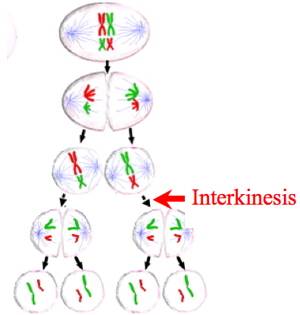Interkinesis
|
|
EUGENE M. MCCARTHY, PHD GENETICS
| < | Mitosis | Meiosis | > |
 Image derived from a drawing by Saperaud
Image derived from a drawing by Saperaud
In many organisms, particularly plants, the two daughter cells produced by meiosis I begin immediately to prepare for the second meiotic division. In others, however, nuclear envelopes temporarily appear and enclose each of the two separated sets of chromosomes between telophase I and prophase II, and there is a period of rest. This period, during which envelopes are again visible, is called interkinesis (pronounced "IN-ter-kə-NEE-səs"). Sometimes it is called, less properly, interphase, but it is not a real interphase because no replication occurs. Each chromosome is still composed of two sister chromatids.
The period between meiosis I and meiosis II is sometimes called "interphase," this is confusing because it is not a true interphase such as that seen between rounds of mitosis because no synthesis occurs (all chromosomes have two chromatids throughout this stage).
| Etymology: The prefix inter- is from the Latin preposition inter, meaning "between." Some other common bio terms starting with this prefix are: interphase, internode, and interstitial. The suffix -kinesis is from the Greek word kinesis, meaning "motion." Many terms in biology have this ending, for example, cytokinesis. |